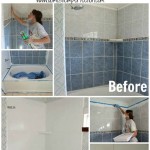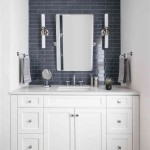Changing Tiles in a Bathroom: A Comprehensive Guide
Bathroom renovations often involve tile replacement to update aesthetics, repair damage, or improve functionality. Changing tiles is a significant undertaking that can dramatically transform the bathroom environment. This article provides a comprehensive understanding of the process, considerations, and essential steps involved in a successful tile replacement project.
Preparation and Planning: Laying the Groundwork for Success
Before commencing any physical work, meticulous preparation is paramount. This initial phase involves assessing the existing bathroom structure, selecting appropriate replacement tiles, and gathering the necessary tools and materials. Failure to adequately prepare can lead to increased costs, delays, and subpar results.
The first step involves a thorough inspection of the existing tiles and underlying substrate. Identifying the type of existing tile (ceramic, porcelain, natural stone, etc.) is crucial, as this will influence the removal method and the type of adhesive required for the new tiles. Note any signs of damage, such as cracks, loose tiles, or water damage. Water damage can indicate underlying structural issues that must be addressed before proceeding. Mold or mildew growth also suggests potential moisture problems that require remediation.
Next, assess the substrate beneath the existing tiles. Common substrates include concrete, cement board, and plywood. The condition of the substrate significantly impacts the adhesion and stability of the new tiles. Check for flatness, stability, and any signs of rot or decay. Uneven or unstable substrates require leveling or reinforcement before tiling can begin. Plywood, in particular, should be checked for water damage and replaced if necessary.
Accurate measurements of the tiling area are essential for determining the quantity of tiles, adhesive, grout, and other materials needed. Create a detailed layout plan that accounts for tile size, grout lines, and any design elements. Consider the placement of accent tiles, borders, or patterns. A well-defined layout minimizes tile waste and ensures a visually appealing final product. When calculating tile quantity, it is advisable to purchase approximately 10-15% extra to account for cuts, breakage, and potential future repairs. Also, accurately mapping out any fixtures (toilets, sinks, etc.) and making the necessary adjustments to the tile layout will ensure a professional and aesthetically pleasing finish. This also includes accurately measuring for corner cuts and accounting for the thickness of the grout lines.
Selecting the appropriate replacement tiles is a critical decision that impacts both the aesthetic appeal and the functional performance of the bathroom. Consider factors such as tile material, size, finish, and slip resistance. Porcelain tiles are generally preferred for bathrooms due to their durability, water resistance, and low maintenance requirements. Ceramic tiles are a more cost-effective option but may be less durable than porcelain. Natural stone tiles, such as marble or granite, offer a luxurious aesthetic but require more specialized care and maintenance. Tile size should be chosen based on the size of the bathroom and the desired visual effect. Larger tiles can create a more spacious feel, while smaller tiles may be better suited for intricate patterns. Select a tile finish that provides adequate slip resistance, particularly in areas prone to moisture. Matte or textured finishes are generally safer than glossy finishes. Carefully consider the colour and style of the tiles to complement the existing bathroom fixtures and décor. Gather samples of different tiles and compare them in the bathroom environment to ensure that they meet the desired aesthetic and functional requirements.
Before starting any work, gather all the necessary tools and materials. Essential tools include a tile cutter (manual or wet saw), a notched trowel, a rubber grout float, a sponge, a level, a measuring tape, a utility knife, safety glasses, and gloves. Necessary materials include tile adhesive (thin-set mortar), grout, grout sealer, and any necessary substrate preparation materials (e.g., self-leveling compound, cement board). Ensure that all materials are of high quality and compatible with the selected tiles and substrate. Using the wrong type of adhesive or grout can lead to tile failure. Carefully review the manufacturer's instructions for each product and follow them precisely. Preparing all tools and materials in advance will streamline the tiling process and minimize disruptions.
Tile Removal: Executing the Demolition Phase
The removal of existing tiles requires a systematic approach to minimize damage to the substrate and ensure a safe working environment. Proper techniques and tools are essential for efficient and effective tile removal.
Protecting the surrounding areas is crucial before commencing tile removal. Cover fixtures such as toilets, sinks, and bathtubs with drop cloths or plastic sheeting to prevent damage from falling debris. Seal off the bathroom doorway with plastic sheeting to contain dust and debris within the work area. Wear safety glasses, gloves, and a dust mask to protect against injury and inhalation of dust particles. Adequate ventilation is also necessary. Open windows or use a fan to circulate air and minimize dust accumulation.
Employing appropriate tools for tile removal is essential. A chisel and hammer are commonly used for removing individual tiles. Insert the chisel at the edge of the tile and gently tap with the hammer to loosen the adhesive bond. Avoid excessive force, as this can damage the substrate. A tile scraper can be used to remove larger sections of tile. This tool features a wide blade that is inserted under the tiles to lift them from the substrate. For larger areas, a power chisel or demolition hammer can be used to expedite the removal process. However, caution must be exercised when using power tools to avoid damaging the substrate. Working methodically and carefully, removing tiles one by one to prevent damage to the underlying surfaces. In difficult areas, consider using a heat gun to soften the adhesive before attempting removal. The heat will aid in easier lifting of the tiles.
After removing the tiles, thoroughly clean the substrate to remove any remaining adhesive, grout, or debris. Use a scraper or putty knife to remove stubborn adhesive residue. Sweep or vacuum the area to remove loose particles. Inspect the substrate for any damage, such as cracks or holes. Repair any damage with patching compound or self-leveling compound. Ensure that the substrate is clean, dry, and level before proceeding with tile installation. A clean substrate promotes optimal adhesion of the new tiles. Consider applying a moisture barrier to the substrate, especially in areas prone to moisture exposure. This will help prevent water damage and mold growth. The substrate should be adequately primed before applying the adhesive. Priming enhances adhesion and ensures a strong bond between the tile and substrate. If significant damage to the substrate is observed, replacement may be necessary. When replacing sections of the substrate, matching the depth and material of the previous subfloor is integral to a smooth, even tiling process. Also, verify that any pipes or electrical wiring underneath the substrate are in good condition.
Dispose of the removed tiles and debris properly. Place the debris in heavy-duty trash bags and dispose of them according to local regulations. Consider recycling the tiles if possible. Some recycling centers accept ceramic and porcelain tiles. If the tiles are in good condition, consider donating them to a local charity or reuse them in another project. Responsible disposal of waste materials is an important aspect of any renovation project.
Tile Installation: The Art of Precise Placement
The installation of new tiles requires precision, attention to detail, and adherence to best practices. Proper tile layout, adhesive application, and grout selection are crucial for a professional and long-lasting result. The entire tiling process is a meticulous and often time-consuming activity.
Before applying the adhesive, dry-fit the tiles to ensure proper alignment and spacing. This allows for any necessary adjustments to be made before the tiles are permanently installed. Start by laying out a row of tiles along a central axis of the room. Use tile spacers to maintain consistent grout lines. Check for any gaps or misalignments. Adjust the tile layout as needed to ensure a symmetrical and aesthetically pleasing pattern. Pay particular attention to corners and edges. Use a tile cutter or wet saw to cut tiles to fit around fixtures and in tight spaces. Practice cutting the tiles before attempting to cut the final pieces. Clean the tiles thoroughly after cutting to remove any dust or debris. Dry-fitting allows for the identification of any potential problems before the adhesive is applied. It is a crucial step in ensuring a professional-looking finished product.
Applying the adhesive correctly is essential for ensuring a strong and durable bond between the tile and the substrate. Use a notched trowel to apply a thin, even layer of thin-set mortar to the substrate. The size of the notch in the trowel should be appropriate for the size and type of tile being installed. Hold the trowel at a 45-degree angle and apply the mortar in a sweeping motion. Avoid applying too much mortar, as this can cause the tiles to slip or become uneven. Press the tiles firmly into the mortar, using a slight twisting motion to ensure good adhesion. Use tile spacers to maintain consistent grout lines. Check the tiles for level and alignment using a level. Adjust the tiles as needed to ensure a flat and even surface. Work in small sections to prevent the mortar from drying out before the tiles are installed. Regularly clean the tiles with a damp sponge to remove any excess mortar. Following the manufacturer's instructions for the thin-set mortar is crucial. Different mortars have different setting times and application requirements. Allowing the mortar to dry completely before applying grout is absolutely critical.
Grouting is the final step in the tile installation process. Grout fills the spaces between the tiles, providing a waterproof seal and enhancing the aesthetic appearance of the tiled surface. After the mortar has fully cured, remove the tile spacers. Mix the grout according to the manufacturer's instructions. Apply the grout to the tile surface using a rubber grout float. Work the grout into the grout lines, ensuring that they are completely filled. Remove excess grout from the tile surface with a damp sponge. Rinse the sponge frequently to avoid spreading the grout. Allow the grout to dry slightly before polishing the tile surface with a clean cloth. This will remove any remaining grout residue and reveal the true color of the tile. After the grout has fully cured, apply a grout sealer to protect it from stains and moisture. Grout sealer should be applied every six months to one year to maintain its effectiveness. Different types of grout are available, including sanded grout and unsanded grout. Sanded grout is typically used for grout lines wider than 1/8 inch, while unsanded grout is used for narrower grout lines. Select the appropriate type of grout based on the width of the grout lines, as well as the type of tile installed.

Can You Change Tile Color Without Replacing It Maryland Tub

How To Renovate Bathroom Without Removing Tiles Multipanel

How To Upgrade Bathroom Tile Without Replacing

The Best Way To Remove Old Shower Tile

Is Ceramic Tile Refinishing Worth It

Preparing Walls For Tiling Removing Old Tiles Bathroom Guru

Easy Diy Guide On Removing Tiles From Walls Fantastic Handyman Au

How To Remove A Tile Floor

8 Ways To Update Your Vintage Tile Bathroom Building Bluebird
Help Tile At Bottom Of Shower Changing Color Ceramic Advice Forums John Bridge
Related Posts







